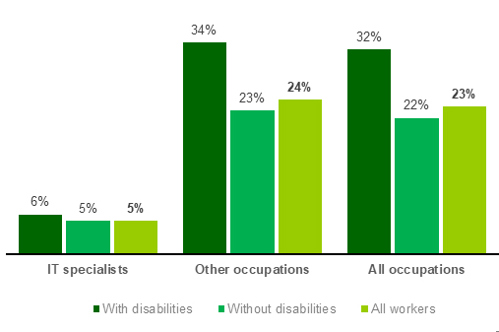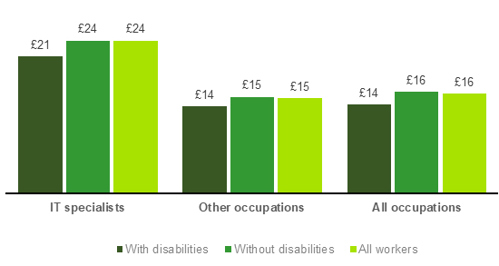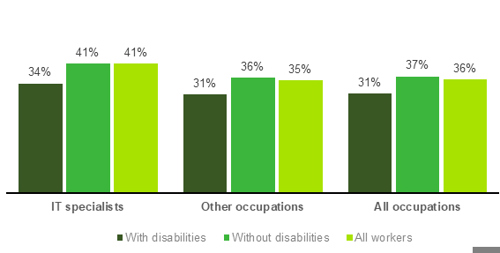Working hours and benefits
Full-time and part-time working
IT specialists in the UK are much less likely to work part-time than other workers, and in 2022 just 5% were working part-time hours compared with 23% of workers as a whole.
The incidence of part-time working was much the same for IT specialists with/without disabilities (6% and 5% respectively) though again, the incidence of part-time working for those working in IT was five times less than amongst disabled workers more generally (32% of which worked part-time during 2022).
Whilst the relative incidence of part-time working is low for disabled IT specialists and IT specialists as a whole, it would appear that, for the majority at least, this is out of choice - albeit a slightly less common choice for those with disabilities (59% of which stated that they worked part-time as they did not want a full-time job over the 2018–22 period compared with 81% of IT specialists without disabilities).
Incidence of part-time working (2022)

Source: Analysis of ONS Quarterly Labour Force Survey by BCS
Remuneration
In 2022 the gross hourly pay for IT specialists with disabilities was £21phr - 89% of the remuneration for IT specialists without disabilities (£24phr). Pay for IT specialists with disabilities was however, 55% higher than that of other workers with disabilities (£14phr).[3]
Median hourly earnings of full-time employees (2022)

Source: Analysis of ONS Quarterly Labour Force Survey by BCS
Responsibility
Using Managerial/supervisory status as a proxy for the likelihood that individuals are given responsibility within their work, it would appear that during 2022, IT specialists with disabilities (employees) were less likely to hold positions of responsibility than those without disabilities (i.e. 34% stating that they were a manager/foreman/team leader compared with 41% of IT specialists without disabilities).
In both cases the likelihood of individuals holding positions of responsibility was higher than others in the workforce as a whole amongst which, just 31% of workers with disabilities and 37% of those without stated that they were a manager/foreman/team leader.
Employees in 'responsible positions' (2022)

Source: Analysis of ONS Quarterly Labour Force Survey by BCS
[3]All figures given are for full-time permanent employees.













